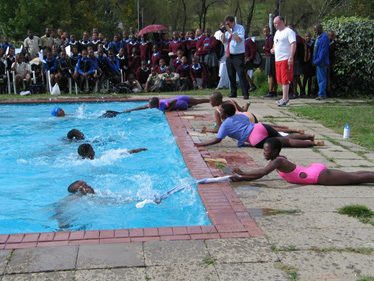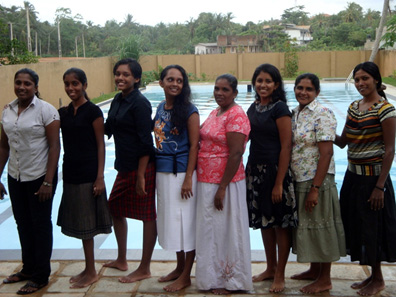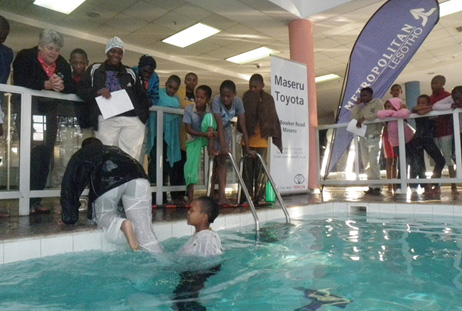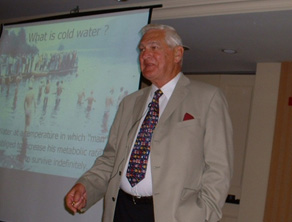The History of the first decade of The Lifesaving Foundation
“The Lifesaving Foundation supports and promotes evidence based research into drowning prevention and rescue.”
Beginning
In 1999 the Royal Life Saving Society Branch in Ireland (RLSS IRELAND) received a request, from the then RLSS Commonwealth Secretary General John Long, to provide financial and technical support to a small lifesaving organization based in Mombasa, Kenya, as a 2000 CE millennium project. The Branch agreed to do so but due to “African time” delays it was early in 2002 when two pool lifeguard trainers travelled to Mombasa to train a group of pool and beach lifeguards for employment in local hotels. An internationally recognized lifeguard qualification would not only enable the individuals concerned to gain employment but would also boost the local tourism industry. The project was very successful and was followed by a further request in 2003 to send beach lifeguard trainers as a German tour group had indicated that it would include Mombasa as a holiday destination in its brochures if beaches attached to hotels were lifeguarded. RLSS IRELAND was not in a position to financially support a long-term project but a small group of members were interested in continuing so a new independent organization was formed. It was incorporated as The Irish Lifesaving Foundation and registered as an independent charity in 2003. Plans were made to return to Kenya but the security situation deteriorated greatly and the initial project collapsed (RLSS IRELAND, 2004).
The Early Days
Shortly after the initial approach by John Long, RLSS IRELAND began collecting good quality swimwear, towels, goggles, rescue equipment and lifeguard clothing from its membership and forwarding it to the RLSS Commonwealth headquarters for distribution around the world. A large quantity of clothing and equipment was transported to England for the 2001 RLSS Commonwealth Lifesaving Conference. Delegates from developing nations were invited to fill their suitcases with whatever they could bring home with them. Many international airlines were helpful and ignored weight limits when approached by the RLSS. Unfortunately all of this stopped when oil prices rose but by 2008 the Irish Lifesaving Foundation had supplied clothing and equipment to lifesavers in Antigua, Barbados, Botswana, Gambia, India, Kenya, Lesotho, Mauritius, Mozambique, Seychelles, St. Lucia, Uganda, Zambia and Zimbabwe. Shortly after the Commonwealth Conference requests were received to financially support projects in Lesotho and Uganda. The foundation board considered both requests and in the light of the initial Kenya experience decided that in future it would have at least two projects ongoing at any time in case one collapsed.
In Lesotho a church charity, The Lesotho Durham Link, was providing water safety education in schools in response to a serious national drowning problem. A number of large dams had been constructed there to sell fresh water and electricity to South Africa and a nation used to mountain streams and rivers was adjusting to living with large deep bodies of water. Money and equipment (including Lesotho’s first mountain rescue stretcher) were supplied and arrangements made to send representatives to Lesotho to upgrade lifesaving skills. A bonus training opportunity arose by way of Lifesaving South Africa hosting the 2003 RLSS Commonwealth Lifesaving Championships. Two Foundation representatives, John Connolly and Brendan Donohoe, travelled to Durban where the organizing committee generously permitted the use of the championship pool to train a group of Lesotho lifesavers. After the championship the training moved to Lesotho, where a new national lifesaving organization, The Royal Lesotho Lifesaving Association, was founded with His Majesty King Letsie III as patron. Funding was then provided on an ongoing basis to support schools based water safety training
.
Schools based water safety training in Lesotho.
Two requests were received from lifesavers in Uganda. The first was to fund water safety radio advertisements aimed at boat users on the great lakes and the second the provision of a motorcycle for transport within Uganda. The radio advertisements were funded as thousands of persons drown annually on Lake Victoria and Lake Albert (Wiebenge, 2010). The motorcycle request was unsuccessful but it pointed to a distance problem that would arise again and again over the intervening years, i.e. the localization of training due to a lack of resources within developing countries.
The incorporation of the Irish Lifesaving Foundation as a not-for-profit company and a registered charity in Ireland in 2003 was accompanied by a great disappointment and a key learning event. A young family, visiting Kenya, had drowned in Mombasa Port in 2002 whilst taking part in a holiday boating outing. Although the sinking of their craft had been observed there was no rescue service in the port and they drowned before help could be organized. During the 2002 World Congress on Drowning in Amsterdam the matter was discussed with both International Lifeboat Federation and Royal National Lifeboat Institute (RNLI) representatives and an outline plan was devised. It was agreed that the Foundation would purchase a second-hand inshore lifeboat from RNLI, the International Transport Federation would arrange to have it transported to Mombasa and RNLI would provide free training and accommodation at its UK training centre for the first Ugandan crew-members. Tragically it all fell apart due to a local inability to house and maintain the lifeboat and its associated equipment. Lifeboats are high maintenance rescue items and are costly to run. As mentioned previously the Kenyan economy had collapsed and local funding was not available. The proper storage of training and rescue equipment would become an ongoing problem for the Foundation.
Growing Up
From 2003 to 2009, in addition to collecting and distributing swimwear and equipment to organisations in developing countries, the Foundation funded various projects. These included a number of school and youth organisation based water safety education projects in Lesotho, Sri Lanka, Uganda, Kenya, and Tanzania. A Lifeguard Training Project supported the training of lifeguards in Gambia, South Africa, Kenya and India. Lastly, a number of water safety leaflets were published which are freely available on the Publications page of this site.
In addition to the above activities, four key projects stand-out and are worthy of separate description. These are the Sri Lanka Women’s Swimming Project, the Lifeguard Training Project, drowning research and the Ireland Medal.
The Sri Lanka Women’s Swimming Project
The Sri Lanka Women’s Swimming Project was founded by Mrs. Christina Fonfe in the aftermath of the 2004 Asian tsunami (Fonfe, 2010). In many countries, for cultural reasons, females are not taught to swim and during the tsunami the majority of those who died were females or children, consisting of up to 80% of all casualties in some regions (Crawford, 2005). This project aims to reduce drowning deaths by using female swimming teachers to teach women and teenage girls to swim and then showing them how they in turn can teach their own children and families to swim. The best pupils receive further training as swimming teachers with internationally recognized qualifications (e.g., Swimming Teachers’ Association) and are employed as such by the project and pool operators with micro-economic benefits. The Foundation has been one of the projects main supporters assisting in paying the salaries of the core swimming teachers. The project is now incorporated as a charity in the United Kingdom.

Sri Lanka Women’s Swimming Project
The Lifeguard Training Project
Mrs. Pat Wilcox’s involvement with lifesaving in Soweto, South Africa, began in 1990, when access to the township became possible following a change of government. Her initial role was as a swimming instructor and lifesaving/lifeguard examiner but it soon expanded into her training unemployed young swimmers as lifeguards for employment in public and private pools, in nearby Johannesburg. Foundation members first met Pat during the 2003 Commonwealth Championships but it was not until a 2005 visit to Soweto with her (prior to travelling on to Lesotho) that the Foundation became aware of this aspect of her work. Money is always a problem for her, even though she works on a voluntary basis, as the youths have little or no money to pay for anything, including their assessment fees. The Foundation has financially supported this project since 2005. Through her dedicated work hundreds of youths have been given a career by way of their obtaining a vocational qualification that gives them both a job and status within their community. The Foundation has also supported the training of lifeguards in India, Gambia and South Africa.
Drowning Research
Foundation members have always been conscious of the value of their promoting research into lifesaving matters and have written and presented papers at various national and international conferences. Having a close association with the United Kingdom members were aware that there are often many differences in the causes of drowning deaths, even in close neighbors such as Ireland and the United Kingdom. In Ireland a high percentage of accidental deaths take place in the sea whereas in England they occur in inland waters, due in some part to the fact that Ireland’s major cities are all coastal while England’s are inland (Connolly, 1984). Foundation aid recipients have been encouraged to carry out local research into the causes of drowning and to develop their own national award schemes based upon their research. The majority of lifesaving organizations in developing countries often adopt award schemes produced for other nations because training materials are easily available or have been supplied to them free of charge or at a subsidized price. Sometimes there are valid reasons behind decisions to adopt another’s award scheme. Lesotho, for example, is surrounded by South Africa and if a lifeguard is seeking employment it is essential that he or she hold a South African award but Lifesaving South Africa is mainly focused on surf safety (its national problem) whereas Lesotho is land-locked and has still water and river crossing drowning problems. The Foundation has tried to encourage local drowning research in developing countries with a view to the creation of water safety programmes targeted on local problems. It has had little real success with this project due to the low level of official reporting on drowning deaths in developing countries where it has a low priority.

Lifesaving and Lifeguard training in Lesotho
The Ireland Medal
The Ireland Medal was introduced in 2004 as a joint project between the Irish Lifesaving Foundation and RLSS IRELAND to mark the centenary of the RLSS branch and the birth of The Irish Lifesaving Foundation (RLSS IRELAND, 2004). A gilded sterling silver medal is awarded annually ‘to an Irish person or organization or to a person of Irish descent in recognition of an exceptional contribution to saving lives from drowning’. The medal has been awarded 9 times (Connolly, in press) and now has a high status within lifesaving circles due to the quality of recipients. It generates valuable publicity for lifesaving and frequently draws attention to hidden aspects of drowning such as Foyle Search and Rescue proving, by reducing the number of annual drowning deaths in their local river from over 30 to 3, that it is possible to successfully prevent suicide by drowning (Wilson, Smyth & Connolly, 2010). The medal ceremony is accompanied by the Ireland Seminar, a free public seminar addressed by lifesaving experts present at the award ceremony.

Admiral Frank Golden (2004 Ireland Medal recipient) speaking at the 2005 Ireland Seminar.
Compiled in 2009 by Mr. John Connolly, Director and founder member of The Lifesaving Foundation.

